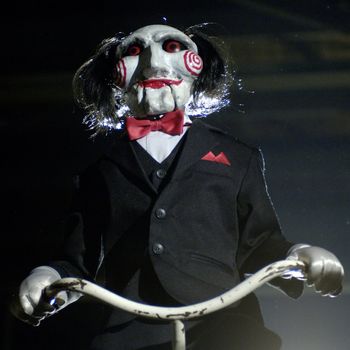
Unlike the slasher movies of the 1980s or the exploitation horror films of the 1970s, the modern wave of torture films (or, as New York’s David Edelstein dubbed it, “torture porn”) has been marked by highly stylized violence with landscapes designed for and devoted to pure punishment. The subgenre thrived in the aughts, with a slew of like-minded efforts like 2004’s Saw, which kicked off the mainstream U.S. torture wave; The Collector; Hostel (and most of Eli Roth’s filmography); anything from Rob Zombie; and The Human Centipede. Things have gotten quieter lately on the graphic suffering front, but the tenth entry in the Saw franchise arrives this weekend after missteps in the franchise, hoping to rekindle your interest in torture tourism.
The question is: Were the Saw movies actually good enough to merit getting back on the tricycle for a tenth time? The answer: … Sort of! Like the sin hunters of the ’80s, the franchise’s diabolical Jigsaw (a.k.a. John Kramer, played by Tobin Bell) wanted to weed out the deviants and the ungrateful — but he typically gave victims a chance to redeem themselves and reclaim their souls with a fresh perspective on how to truly cherish the gift of life. Saw’s effectiveness as a fable is in the eye of the beholder, but it gets points for trying. As Jigsaw hits theaters, we’ve put together a ranking of all of the Saw movies so far. None of these movies is good compared to, say, The Shining, but compared to one another, there are true winners and losers here. So, let’s play a game.
10. Spiral (2021)
Signature Device: The Shrapnel Canon
The Saw series returned in 2021 with the confusingly titled Spiral: From the Book of Saw. Were we previously aware of a Book of Saw? Did John Kramer write it? Anyway, the ninth movie in the franchise had a lot of hype coming in since Chris Rock was set to star and also reportedly touched up the script. What interesting new blood to have joining the Saw-verse! But it’s a shame there was so much excitement, because Spiral turned out to be confoundingly boring. As Detective Zeke Banks, Rock is gloomy and tired-looking throughout — but not in that world-weary cop way you’d expect from a crime movie. Max Minghella is living somewhere in the middle of the emotional register the entire time as Zeke’s partner, and top cop Samuel L. Jackson is just doing his thing, man.
The skinny for this movie is that people are getting killed in shockingly gruesome ways once again, and the cops who are investigating the deaths draw parallels to the Jigsaw murders of yore. The prior Saw movies are baked into the timeline of Spiral as canon, but this isn’t a “AND EVERYONE WAS IN ON IT THE ENTIRE TIME!” sequel. John Kramer is nowhere to be found, but a new killer replaces Billy the tricycling clown (a pig in a police uniform named Mr. Snuggles), and they’re following the rich Saw tradition of purpose-driven murders. And this time, it’s police brutality and corruption animating our killer to seek vengeance via torture deaths like electrocution, suffocating hot-wax baths, exsanguination, and so on.
The deaths are crazy to watch as always. On that front, Spiral delivers, but it’s almost like there’s too much “normal” narrative driving the story. Saw movies are famously and hilariously plot-dense — just put our victims in a big kill maze and let ’em have it, guys! Spiral is more of a grounded, hard-boiled cop picture than it is a corny, ultra-on-the-nose message movie where so many story elements and characters are retconned in that it obliterates the suspension of disbelief — which is what makes them so fun! Spiral got serious, when the only way to make a Book as outlandish as Saw work is by being entirely too silly. For the crime of being a snooze, Spiral is bringing up the caboose for the Saw train.
9. Saw 3D (2010)
Signature device: The brazen bull oven
Despite the fact that the franchise had accumulated more than $700 million over the course of six movies, and the fact that 3D cost a whopping $20 million to make, the seventh movie feels the cheapest by far. It’s the kitchen-sink chapter. A new character named Bobby (Sean Patrick Flanery) is introduced as the lead — a charlatan who’s amassed fame and fortune thanks to a self-help book he wrote after surviving a Jigsaw game, when in reality he was never a target of the killer at all — and a bunch of past survivors appear to fill out a self-help group and create new bends in the Jigsaw narrative. The flashbacks are constant, filling in the ever-retconned backstory of John Kramer and his minions. The death traps come at such a rapid pace, you wonder who has time to set up all these elaborate games, one of which features the late Chester Bennington not saying one line, but rather, screaming through an entire scene. John’s ex-wife Jill is still kicking, fulfilling John’s last wishes and kind of running around in fear as a corrupt cop named Hoffman (Costas Mandylor) continues to try to usurp Jigsaw’s legacy. Meanwhile, Bobby the poseur has to work through a murder labyrinth to save his wife, but that game is mostly a distraction from the fact that Dr. Lawrence Gordon (Cary Elwes) from the first Saw has resurfaced — and is revealed as an accomplice of Jigsaw from the very beginning.
The return rate on cast members in Saw is one of the franchise’s strengths, but Dr. Gordon — down one foot because he had to hacksaw one off to survive his death game — resurfacing as a top Jigsaw disciple just makes everyone in this universe seem far too willing to join forces with a man who mutilated them in the name of tough love. If you’re a Saw stan, the seventh movie will push the right buttons, but after finishing 3D, it’s clear why the franchise took a seven-year hiatus.
8. Saw IV (2007)
Signature device: Ice block head crusher
The Saw movies put viewers through a lot, and while they admirably pile on enough plot to make sure the movies aren’t just about violence, the crux of a Saw experience is elaborately executed gore. But there are limits to entertaining brutality, and IV crosses them. Jigsaw victims in this chapter are punished for offenses like child abuse and sex crimes, and if violence is going to be your calling card, you have to make a choice: big gore or horrific exploitation. You don’t get to do both. A woman having her scalp slowly ripped off just shouldn’t exist in the same movie as a rape dungeon if you want to maintain some modicum of dignity — especially when the story is about morality and justice.
IV also piles on the twists. You thought Donnie Wahlberg died in II? Twist! He’s back! You thought Amanda (Shawnee Smith) and John were the only ones on Team Jigsaw? Twist! He’s got a cop in his pocket! Remember when you saw John’s wife once in a flashback? Surprise! She’s now integral to the plot! None of this even has anything to do with the A plot, which is that SWAT guy Reggie — who was introduced in II — now has to survive a Jigsaw game to save a pair of fellow officers. Also, even though the movie begins with the body of John Kramer being autopsied, the movie whiplashes you in the climax, revealing that IV actually took place in a concurrent timeline with III, with the characters and narratives colliding in the triage operating theater featured in that third movie. So, IV both starts and ends with John’s autopsy, which means the autopsy doesn’t set the stage for IV so much as transform into a ham-fisted trick play at the end of the movie. Despite how assaulting they are, Saw movies are actually best binged like a TV show — think of it as American Horror Black Mirror Story — because there are so many threads to hold on to, you need to watch as fast as possible to keep up. It’s not that IV is too intellectually dense to understand. It just starts to feel like cheap tricks.
7. Jigsaw (2017)
Signature device: The laser-cutter collar
After a seven-year absence, the gang’s all here: the creepy doll on its tricycle, a torture gauntlet filled with blame-shifting sinners, the signature theme song, the ominous recorded voice of Tobin Bell, excised skin cut in the shape of puzzle pieces, and even a kind of museum filled with a greatest hits of Jigsaw’s death devices. Saw cleans up pretty well in these modern times: This is the first movie that actually looks sort of expensive, and it trades the sickening green color palette of the first seven efforts for actual daylight. (Based on a visible license plate, it looks like Saw takes place in New Jersey, and Jigsaw finally makes the state look like something other than a dreary companion universe to Silent Hill.)
While eight is not a bad Saw movie, it’s not very exciting, either. The main game in the torture barn drags, with long gaps between rounds of punishment. There’s one of those signature Saw timeline twists that makes you say, “Oh come on, did you guys just make this up in the edit room?” And the finale lacks the rapid rising action that gave each previous movie its race-to-the-big-finish feel. However, the kills and mutilations look fantastic, and it’s nice to know that after all these years and all these deaths, watching someone melt from the inside out after being injected with hydrofluoric acid can still be shocking. It’s also got a pretty good sense of humor sometimes, which is a nice new feature. Saw still has the power to shock, but it’s also a little less self-serious. The seventh sequel is not an unwelcome entry, but it does hang around the low-middle of the pack.
6. Saw X (2023)
Signature Device: The Bone Marrow Scale
Saw number ten is taking things way back, and nothing says “the last sequel didn’t work out” like veering hard back into the original cast of your franchise and ditching the new class from the prior movie. Sorry, Spiral! In X, Jack Kramer (Tobin Bell) returns to the decades-spanning series with more vengeance on his mind. This time around we find John near the end of his life, desperate for a Hail Mary cure to his terminal brain cancer. When he gets tipped off to an unapproved miracle treatment, obviously the man known as Jigsaw leaps at the chance to live, but is devastated when he realizes the entire procedure was just some evil cash-scraping scam and the cancer is still going to kill him. But what happens when you piss off John Kramer? Jigsaw comes out to play his little game and teach some lessons. Fuck around and find out what the inside of your skull looks like!
The franchise is sorry it took your toys away in the last movie, but thankfully brings many back this time around. Billy rides again with his trike and silly hair. A few Saw all stars return to the fold (no spoilers!) so you can point at the screen and shout. There are silly jokes and a truly heinous wig, and all of it adds up to the much-needed fun we missed out on in Spiral. However — and there’s a big however — even though X delivers some outstanding kills and one of the most truly stomach-churning traps of the entire series thanks to a Gigli saw, it is unavoidably uncomfortable that Jigsaw is out here killing Mexicans in a warehouse under the banner of righteousness. The big bad is a statuesque Norwegian woman masquerading as a doctor, and it would have been so easy to avoid this gross power dynamic entirely. Instead of sacrificing all these Latin subordinates being exploited by a white Scandinavian sociopath, they could have just cast this movie differently all together! So, even though Saw X actually goes off pretty great if you’re a Saw die-hard, the movie falls down in the rankings because of this unforced error. You were fun, Saw X, but that’s a bad taste to leave people with.
5. Saw V (2008)
Signature device: The blood-collecting table saw
This one is fun because its central conflict is purely entertaining. An FBI agent named Strahm (Scott Patterson) is rightfully suspicious of the “hero” cop Hoffman, who revealed himself to audiences in IV as a longtime Jigsaw associate. Their cat-and-mouse game is good drama, but learning more about Hoffman’s dark side means we spend a ton of time in flashbacks learning his origin story, and seeing him ex post facto sewn into almost every Jigsaw kill that took place over the first few movies. The beginning of V also takes place chronologically before the autopsy of John Kramer, which means III, IV, and part of V exist before Kramer is fully caught and cut open. That is a lot of narrative stacking, and further emphasizes the serial-TV nature of the franchise, which is both a pro and a con.
The main game in V, though, is one of the best: It’s another group contest where a handful of unsavory strangers (two of which are Meagan Good and Julie Benz) have to work together — a.k.a., against their natural instincts — to survive their prison of torture devices. There’s heartwarming cooperation and redemption, but also vicious backstabbing, and it makes for the best murder-house dynamic in the franchise.
4. Saw III (2006)
Signature device: The rack
The game changes by III, because we know Jigsaw isn’t working alone. Amanda is now fully part of the story as his lieutenant, working to become his successor after his terminal cancer finally claims him. (John’s diagnosis, and the fallout from it, is what sets him on this whole moral-vigilante trip in the first place.) III is particularly plot-heavy: There’s the contentious mentor-mentee and father-daughter dynamics of John and Amanda at play; there’s the fact that he’s dying, and a kidnapped surgeon has to keep him alive in a dirty triage unit while wearing a collar outfitted with shotgun shells ready to release if John’s pulse goes out. And then there’s the main game, with a man named Jeff (Angus Macfadyen) who has to work his way through a Jigsaw trap palace in order to reach existential redemption. (The man Jeff encounters drowning in a vat of freshly milled, rotting pig intestines is the franchise at peak gross.)
As with all Saw movies, every element is connected, but by III, the plot starts requiring some yarn to keep track of. How many tasks can a few serial killers possibly take on? The answer is, more than you could possibly imagine. The third movie doesn’t go over the edge, but it does start to feel like John is setting his subjects up to fail, and the game shouldn’t be rigged quite so hard if he really wants people to walk the path of redemption. There are extra points for emotional nuance, and that keeps III from drowning in an ocean of sameness. On the downside, Dina Meyer dies in the rib separator, and she is missed.
3. Saw VI (2009)
Signature device: The acid injector
A very entertaining thing happens in the sixth movie: Saw tunes into society at large and focuses its punishment on predatory lenders and amoral insurance companies. Pretty much everyone put through a Jigsaw test in this movie earns their living by exploiting high-risk mortgage recipients or revoking medical insurance from people with preexisting conditions. Saw was always a morality tale, but VI lines up the hammer and hits the nail square on the head. At this point, the aesthetic of Saw shifts into “high-end Syfy series” — which feels right, since the franchise plays more like a TV series than a group of movies, and the savage capitalism narrative makes it almost a self-contained chapter in the Saw story.
This time, the man who must make it through Jigsaw’s labyrinth is an insurance-company executive who once rejected John Kramer’s coverage request for an experimental cancer treatment. But instead of being a soulless bastard, he’s actually pretty likable, making selfless decisions within the death maze to try to save others at a physical cost to himself. Six movies deep, there’s a lot of other stuff going on, too: John’s ex-wife is now in the picture, and a suspicious character. A police detective who has taken over as the heir to Jigsaw is trying to outsmart the FBI. One presumed-dead character comes back, and there are lots of flashbacks to Team Jigsaw rigging traps together that were showcased earlier in the franchise. But it’s the main game that makes this one most enjoyable, and the topical plot is a nice switch-up for the narrative.
2. Saw II (2005)
Signature device: The used-syringe pit
As is typical in the Saw series, Saw II picks up right where Saw left off. This one stars Donnie Wahlberg as a no-ethics cop who has to play Jigsaw’s game if he wants to rescue his son from a dingy house that’s basically one big Rube Goldberg death trap. The first sequel trades the novelty of the premise for extra gore, but that’s what sequels do, and it’s the first to introduce the gauntlet format that will become common in the franchise: A bunch of people in a huge torture maze have to find their way out by following all of the sacred rules.
And boy, do we hear a lot about the rules in Saw II. Jigsaw has, by now, been unmasked as John Kramer, and spends most of the movie in a sit-down with Wahlberg’s detective, which gives him a lot of time to proselytize about the value of life and speak in riddles. It’s a little much, but at least Dina Meyer is on hand as a supporting cop to make the dull stretches substantially cooler by just being Dina Meyer. Shawnee Smith reprises her role as the rare Jigsaw trap survivor, Amanda, and catalyzes the franchise’s best “Oh, shit!” moment, which also serves as the tip-off for how vast and interconnected the Saw mythology will eventually become. If you’ve bought into the Saw movies, II ups the violence without totally jumping the shark, and is a worthy follow-up to the original.
1. Saw (2004)
Signature device: The iconic reverse bear trap
Upon revisitation, the original Saw is practically quaint compared to the rest of the series, which levels up the gore and transforms the simple starting plot into a Byzantine rat maze of interlocking and overlapping narratives. But it’s also the only “torture” franchise that aims to embed a morality tale into its core. In Saw, Cary Elwes plays Dr. Lawrence Gordon, a skilled physician who gets locked in a dank basement bathroom place with a photographer (played by co-writer Leigh Whannell, who also starred in the Saw short film) who’s been secretly stalking him for an unknown client. As with all Jigsaw games, the men must perform extreme acts of mental and physical violence to prove that they deserve their lives.
The original is the only movie actually directed by James Wan, and it’s still the best; “How far would you go to survive?” is still a perfect premise for a horror movie. The elaborate devices constructed to inflict pain were innovative at the time. The scenes in the parking garage and the dark apartment, lit only by camera flashes, remain chilling. The sound of Jigsaw’s gravely voice pouring out of the tape recorder is still as ominous a sound as one could imagine, and the big reveals still come as a genuine shock. Saw holds a deserving place in horror-film history.





